If you are in Canada, Parts ConneXion is having a small Summer Sale ending June 30th:

https://www.partsconnexion.com/
I exclusively use Neotech Solid Core, but I buy domestically:
So this 12 Gauge looks like a good fit between the UcPure and UcBalancer:

https://www.partsconnexion.com/NEOTECH-70756.html
But they have other stuff like Hammond Transformers, etc. Happy DIY'ing.
https://www.partsconnexion.com/
I exclusively use Neotech Solid Core, but I buy domestically:
So this 12 Gauge looks like a good fit between the UcPure and UcBalancer:
https://www.partsconnexion.com/NEOTECH-70756.html
But they have other stuff like Hammond Transformers, etc. Happy DIY'ing.
Hello,
Solid core can be difficult to crimp properly, You will need a serious connector with the right crimping tool to get it right.
Greetings, Eduard
I can see how that can me an issue depending on the termination.
But for Ian Canada Products, I have used 18G Silver Solid Core over the years without a hitch for DC Connectors (Andrea's Clock) and 30G Silver Solid Core for microUSB connectors (3rd party).
Recently, I have moved onto Cooper for UcPure and USB connections. The 12G Cooper Solid Core fits seamlessly on the UC* terminals and screw tightly with ease once it flush fits. I will try 20-22G Cooper Solid Core this week as I am making USB cables to prepare to use with the UC* this weekend.
So I was able to easily solder 18G for Switchcraft DC connectors and they easily insert and screw tightly in the power terminals on the other end. The 12G will likely be too difficult to solder as an endpoint, but between two heavy duty devices they easily insert and screw tightly in the power terminals.
I'll have photos at the end of the week with the 12G in the power terminals. Yes, Solid Core is stiff depending of the Gauge.
The only time I had to worry about crimping was with the Molex Mini-Fits, but I think I can avoid since Continuous Output does not go into Pure Mode. Only Switch Mode seems to go into Pure Mode, so I'm sticking with the Power Terminals.
From Day One, I have always seamlessly mixed Third-Party accessories with Ian Products. This is DIY after all, so one should be free to optimise where they see fit. So Solid Core always for Hook-Up Wire, plastic standoffs for RPi and HATs and I even replace the power terminals when I have time.
I get beautiful precise, layered Bass with Andrea's clock but I can't attribute it directly to Solid Core as I've been using since Day One. But I have read Solid Core impressions elsewhere that resembles my impressions. But, YMMV.
I decided to take some photos early with the Neotech Cooper Solid Core 12G in the mix. I only use a Torque Screwdriver, so the Terminal Screws were screwed in firmly but not overdone.
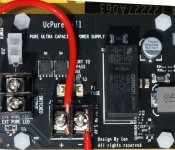
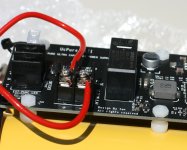

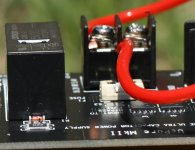
I'll have more photos this weekend as I have packages arriving in a few days to finish off this UcPure 5V project.
Also, Solid Core could be a new trend as it's recommended in one of the UcPure Manuals (I never thought about lower ESR as an attribute going Solid Core @ a lower Gauge):
I know my innovative FPGA DAC Designer oven bakes twisted Solid Core cables for his B&W Diamonds. That's his exclusive Goto even though he has an unlimited budget. And he has ears of an Angel.
So much respect to my DAC Designer and now Ian for at least considering Solid Core as an option.
I also found my Genuine Hirose U.FL Stash:
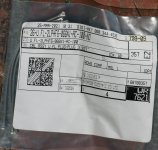
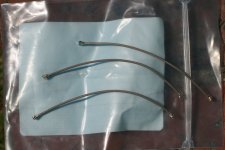
I'm so glad I have extra as I will need another one for my 2nd Ian Stack. Genuine Hirose just makes life much easier in my case. Could be an anomaly, but I already have extra cables and switched over so it's here to stay.
I can't recommend this specific product as this product is now obsolete. There should be alternatives.
I get beautiful precise, layered Bass with Andrea's clock but I can't attribute it directly to Solid Core as I've been using since Day One. But I have read Solid Core impressions elsewhere that resembles my impressions. But, YMMV.
I decided to take some photos early with the Neotech Cooper Solid Core 12G in the mix. I only use a Torque Screwdriver, so the Terminal Screws were screwed in firmly but not overdone.




I'll have more photos this weekend as I have packages arriving in a few days to finish off this UcPure 5V project.
Also, Solid Core could be a new trend as it's recommended in one of the UcPure Manuals (I never thought about lower ESR as an attribute going Solid Core @ a lower Gauge):
Need to be connected to UcPure input J7 with the supplied red and black wires. To reach an even lower
ESR, AWG16 or bigger single core wires are also recommended. Never reverse the wires.
I know my innovative FPGA DAC Designer oven bakes twisted Solid Core cables for his B&W Diamonds. That's his exclusive Goto even though he has an unlimited budget. And he has ears of an Angel.
So much respect to my DAC Designer and now Ian for at least considering Solid Core as an option.
I also found my Genuine Hirose U.FL Stash:


I'm so glad I have extra as I will need another one for my 2nd Ian Stack. Genuine Hirose just makes life much easier in my case. Could be an anomaly, but I already have extra cables and switched over so it's here to stay.
I can't recommend this specific product as this product is now obsolete. There should be alternatives.
Last edited:
Hello,
You could make a '' loop '' to get a much bigger contact area. It will also create a more even distribution of force/load upon the head of the screw. It is not a dynamic load but it will be there all the time.
Or you could use two wires extra compared to the set up in the pictures above. It would reduce ESR by 50 %.
Very probably most of the ESR will be in the connection and in the connector.
You could do a test with a big diameter wire and a connector or a thinner cable directly soldered at the board.
Greetings, eduard
You could make a '' loop '' to get a much bigger contact area. It will also create a more even distribution of force/load upon the head of the screw. It is not a dynamic load but it will be there all the time.
Or you could use two wires extra compared to the set up in the pictures above. It would reduce ESR by 50 %.
Very probably most of the ESR will be in the connection and in the connector.
You could do a test with a big diameter wire and a connector or a thinner cable directly soldered at the board.
Greetings, eduard
Hello,
If i would use this one i would rather solder a solid core cable than crimp it.. Use a powerful iron, pretin the connector and pretin the solder core before soldering it. Remove the heatshrink before doing this so you heat up the metal where you want the heat to be.
Probably making a loop yourself will be easier and will create an easier highway for the current. Of course you can use a tool to flatten the solid core to create more surface area.
Greetings, Eduard
If i would use this one i would rather solder a solid core cable than crimp it.. Use a powerful iron, pretin the connector and pretin the solder core before soldering it. Remove the heatshrink before doing this so you heat up the metal where you want the heat to be.
Probably making a loop yourself will be easier and will create an easier highway for the current. Of course you can use a tool to flatten the solid core to create more surface area.
Greetings, Eduard
SC-Pure 22.5792/24.5760 MHz
I recently spent a lot of time listening to the new SC-Pure clocks. I have to say I’m so happy with them.
Really great clocks play the music layer by layer just like the flow of clouds. Never mix the sound images up. I really enjoyed this experience.
I went through listening to all my music library over again and was surprised with many new discoveries.

Ian
I recently spent a lot of time listening to the new SC-Pure clocks. I have to say I’m so happy with them.
Really great clocks play the music layer by layer just like the flow of clouds. Never mix the sound images up. I really enjoyed this experience.
I went through listening to all my music library over again and was surprised with many new discoveries.

Ian
Thanks for the advice fellas. I just focus in the context of implementing Ian's products, not Engineering Theory.
As long as the Solid Core Wire is flat to the bottom surface and flat to the Screw Washer, I'm set. Even if the Washer is angled as long as it's flat it's making solid contact direct to the Solid Core Wire. So both sides making direct, flat contact should be good.
As long as the Solid Core Wire is flat to the bottom surface and flat to the Screw Washer, I'm set. Even if the Washer is angled as long as it's flat it's making solid contact direct to the Solid Core Wire. So both sides making direct, flat contact should be good.
Mission Accomplished! Packages arrived. My main goal for the Summer Project was UcPure 5V. I'm offline on this site all of July for holidays now that the Main Summer Project is out of the way.
This UcPure 5V will replace my triple stack 5V to power a USB optical cable. This frees up my triple stack 5V to focus on getting the StationPi up and running since RPi needs PWWWR.
I'll try to report back in August how well the "Pure Mode" works with the triple stack 5V powering both the RPi and Audio side of the StationPi.
This freed up some time as right now I'm isolating CPU cores with specific Audio Apps on my realtime low latency system. I dedicate 3 cores to Audio apps and 1 core to RPi tasks. Need to prepare it for the StationPi transfer and Q7, so I updated the OS and kernel.
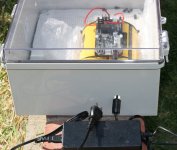
^^^ I've been using this Plastic Case that locks for all of my Ian's Power Supplies to break in. Now, it's time to break in the UcPure 5V.
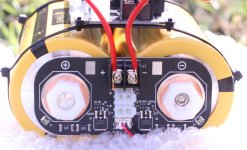
^^^ You can see the other side of this beautiful, thick Neotech 12G Cooper and how it seamlessly integrates with the UcBalancer. I was determined to Heat Shrink, but with the plastic nylon M12 Nuts there's absolutely no need.
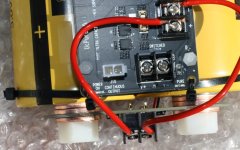
^^^ I'm glad I procured third-party Cooper Washers because it included a few extra. As I suspected, I had to double up on the Washers as the pointy end of the UcBalancer Terminals hit the Eatons with a Single Washer. I like spacing and I'm overly-cautious. For the 16V build, I'm going to try to get Cooper Washers from where I get my Cooper Bussbars. The Cooper Bussbars are so nice and thick. The Cooper Washers are okay, but a bit thin for my taste. They are Machinists so should be able to custom build.
I'm definately excited. I've been waiting to implement since the first UcPure and StationPi release, but pre-ordering and waiting for Eaton Balance Boards delayed the inevitable. UcBalancer motivated me to finally get this done.
I'm looking forward to UcPure 3.3V if triple stack 5V StationPi works out and especially Sc-Pure for my Battery Transportable Rig. So Summer Project not officially over, but the Main important is out of the way.
This UcPure 5V will replace my triple stack 5V to power a USB optical cable. This frees up my triple stack 5V to focus on getting the StationPi up and running since RPi needs PWWWR.
I'll try to report back in August how well the "Pure Mode" works with the triple stack 5V powering both the RPi and Audio side of the StationPi.
This freed up some time as right now I'm isolating CPU cores with specific Audio Apps on my realtime low latency system. I dedicate 3 cores to Audio apps and 1 core to RPi tasks. Need to prepare it for the StationPi transfer and Q7, so I updated the OS and kernel.

^^^ I've been using this Plastic Case that locks for all of my Ian's Power Supplies to break in. Now, it's time to break in the UcPure 5V.

^^^ You can see the other side of this beautiful, thick Neotech 12G Cooper and how it seamlessly integrates with the UcBalancer. I was determined to Heat Shrink, but with the plastic nylon M12 Nuts there's absolutely no need.

^^^ I'm glad I procured third-party Cooper Washers because it included a few extra. As I suspected, I had to double up on the Washers as the pointy end of the UcBalancer Terminals hit the Eatons with a Single Washer. I like spacing and I'm overly-cautious. For the 16V build, I'm going to try to get Cooper Washers from where I get my Cooper Bussbars. The Cooper Bussbars are so nice and thick. The Cooper Washers are okay, but a bit thin for my taste. They are Machinists so should be able to custom build.
I'm definately excited. I've been waiting to implement since the first UcPure and StationPi release, but pre-ordering and waiting for Eaton Balance Boards delayed the inevitable. UcBalancer motivated me to finally get this done.
I'm looking forward to UcPure 3.3V if triple stack 5V StationPi works out and especially Sc-Pure for my Battery Transportable Rig. So Summer Project not officially over, but the Main important is out of the way.
Last edited:
@Drive Shaft
The best output of a UcPure is the continuous mode output. And the best pleases to take the continuous outputs are the UcBalancer direct output connectors. In this case the wires between UcPure and UcBalancer will be not that significant unless you still use the switched output on UcPure.
Ian
The best output of a UcPure is the continuous mode output. And the best pleases to take the continuous outputs are the UcBalancer direct output connectors. In this case the wires between UcPure and UcBalancer will be not that significant unless you still use the switched output on UcPure.
Ian
The best output of a UcPure is the continuous mode output. And the best pleases to take the continuous outputs are the UcBalancer direct output connectors. In this case the wires between UcPure and UcBalancer will be not that significant unless you still use the switched output on UcPure.
I was seriously considering this solution, but I'm worried this solution is not running in "Pure Mode". I love the beautiful blue LED light when "Pure Mode" is activated on the UcPure.
My plan was to use Switched Output in "Pure Mode" all of July then experiment with Continuous Outputs to see it runs in "Pure Mode".
I definitely would love to use one of the UcBalancer's direct output connectors as I love to Share, but I'll know better after spending some time in "Pure Mode" all of July. If the Pure blue LED light does not light up, then I'll go back to Switched Mode.
@Drive Shaft
The UcBalancer direct output will be super pure mode as long as the UcPure is in pure mode with the blue LED lights up.
But I would suggest change to that direct output only after the system got stable because the direct output is super "PURE" without any fuse for protection.
The UcBalancer direct output will be super pure mode as long as the UcPure is in pure mode with the blue LED lights up.
But I would suggest change to that direct output only after the system got stable because the direct output is super "PURE" without any fuse for protection.
@Drive Shaft
The UcBalancer direct output will be super pure mode as long as the UcPure is in pure mode with the blue LED lights up.
But I would suggest change to that direct output only after the system got stable because the direct output is super "PURE" without any fuse for protection.
WOW, that's good to know. I want. I have a dozen Molex Mini-Fits leftover from LiFePO4 MKIII, so I'll eventually try this solution. The Mini-Fits take up to 20G, so that's my MAX for USB so it works out. The UcPure 5V will power a few+ Solid Core Cooper USB cables with No Mains in theory.
Yes, I picked up "No Fuse" from the UcBalancer Manual. I try to re-read all the Manuals before going into Production. I'll weigh all the concerns, so thanks for the reminder. After a period of stability, I'll likely feel comfortable like I have with previous Ian Canada Power Supplies. All of those have been running solid in "Pure Mode".
I plan to run UcPure 5V 24/7/365 so this should work out well. Same once I go UcPure 16V. UcPure 3.3V will be Switched.
Last edited:
It's great new! Although I have a good enough Pulsar clockSC-Pure 22.5792/24.5760 MHz
I recently spent a lot of time listening to the new SC-Pure clocks. I have to say I’m so happy with them.
Really great clocks play the music layer by layer just like the flow of clouds. Never mix the sound images up. I really enjoyed this experience.
I went through listening to all my music library over again and was surprised with many new discoveries.
Ian
Hopefully the price of SC-Pure won't scare away the interest who is interested in SC-Pure in this bad economy
I´m so curious,so i hardly can not wait to compare to mine Neutron Star NS3 Clocks same frequencys. Driven by double 16v Maxvell Ultracapacitor stacks in pure mode.SC-Pure 22.5792/24.5760 MHz
I recently spent a lot of time listening to the new SC-Pure clocks. I have to say I’m so happy with them.
Really great clocks play the music layer by layer just like the flow of clouds. Never mix the sound images up. I really enjoyed this experience.
I went through listening to all my music library over again and was surprised with many new discoveries.

Ian
@Batenet
Just hope it won't make you wait too long.
I have a Neutron Star2 45.xxxMHz myself. It's a really great clock. I like the sound signature, very musical and with dark background. But what surprised me is that it doesn't use SC-CUT crystal. My Neutron Star could use a customized fundamental AT-CUT crystal (also not the 3rd or 5rd overtone crystal). It must be an art of work to make the non SC-CUT crystals sound that good.
Another thing surprised me is that Neutron Star is not an OCXO. It does have heat element on the PCB, but the turnover temperature is only around 40 degree(C). I think it's just for making the temperature stable against the changing of the ambient temperature.
Neutron Star didn't post any phase noise measurement results or numbers. It must be a magic product. I'm really curious how the designer makes it? The only problem is that the high-end Neutron Star clocks are too expensive. I don't think SC-Pure can reach that price levels.

Just hope it won't make you wait too long.
I have a Neutron Star2 45.xxxMHz myself. It's a really great clock. I like the sound signature, very musical and with dark background. But what surprised me is that it doesn't use SC-CUT crystal. My Neutron Star could use a customized fundamental AT-CUT crystal (also not the 3rd or 5rd overtone crystal). It must be an art of work to make the non SC-CUT crystals sound that good.
Another thing surprised me is that Neutron Star is not an OCXO. It does have heat element on the PCB, but the turnover temperature is only around 40 degree(C). I think it's just for making the temperature stable against the changing of the ambient temperature.
Neutron Star didn't post any phase noise measurement results or numbers. It must be a magic product. I'm really curious how the designer makes it? The only problem is that the high-end Neutron Star clocks are too expensive. I don't think SC-Pure can reach that price levels.

Last edited:
Actually my clock is called NS3,a upgrade over NS2.What about clock?I don´t now,is much smaller than on NS2.Have also possibility to put on extra modules for even lower noise floor.I´m so curious,so i hardly can not wait to compare to mine Neutron Star NS3 Clocks same frequencys. Driven by double 16v Maxvell Ultracapacitor stacks in pure mode.
- Home
- Source & Line
- Digital Line Level
- Asynchronous I2S FIFO project, an ultimate weapon to fight the jitter